Municipal Solid Waste Collector Dies after Falling from Solid Waste Vehicle Hopper Area
Kentucky Case Report: 10KY006
Report Release Date: January 11, 2011
Summary
On a spring day in 2010, a 41 year-old male, solid waste collector, was riding in the hopper area of a solid waste truck when he fell out and struck his head on the pavement. He was riding in the hopper area because the step he usually rode, located at the rear driver side, was broken. Another worker rode the rear step on the passenger side of the vehicle, and a third worker, the driver, drove. After approaching a stop, the driver looked into the rearview mirror and saw the decedent on the pavement. The driver stopped the truck, and he and the other solid waste collector tried to assist the decedent. There was no cell phone service in the area so the driver drove the truck four miles to a store, and called emergency medical services and his supervisor. Emergency medical services arrived at the scene and transported the worker to the nearest trauma hospital where he died six days later.
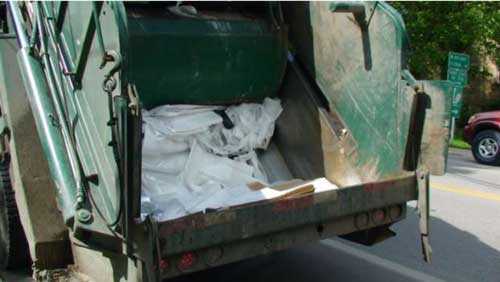 |
|---|
Photograph of hopper from which Collector fell. |
To prevent future occurrences of similar incidents, the following recommendations have been made:
- Recommendation No. 1: Municipal solid waste divisions should require drivers to perform daily post-trip safety checks on solid waste collection vehicles and timely repairs should be performed.
- Recommendation No. 2: Municipal solid waste divisions should ensure that employees are never located on solid waste trucks' rear riding steps when the trucks are traveling faster than 10 miles per hour or traveling more than 0.2 mile.
- Recommendation No. 3: Municipal solid waste divisions should ensure that employees have access to a communication device that can be used during emergency situations.
- Recommendation No. 4: Municipal solid waste divisions should perform job hazard analyses.
- Recommendation No. 5: Municipal solid waste divisions should have a written worker safety program that includes safety training for employees.
- Recommendation No. 6: Municipal solid waste divisions should provide an alcohol/ drug free workplace for employees.
- Recommendation No. 7: Municipal solid waste divisions should consider the feasibility of implementing automated processes for solid waste collection.
Background
The decedent worked for a municipal solid waste division that employed 41 workers. He had worked for the municipality off and on since 1994 in a variety of jobs, mainly as a general laborer and as a solid waste collector. According to a county official, the municipality did not have a written safety program for municipal solid waste collectors and did not provide structured job training. On-the-job training was the standard method of job training.
On the day of the incident, the temperature ranged from 45 degrees Fahrenheit to 62 degrees Fahrenheit.
Investigation
The Kentucky Fatality Assessment and Evaluation program was notified of an occupational fatality involving a solid waste collector falling out of the back of a solid waste truck. The employer was contacted and a site visit was made. Photographs were taken at the scene. The employer, a Kentucky Occupational Safety compliance officer, and the coroner were interviewed for this report.
On a spring day in 2010, three solid waste collectors, working for a municipality, collected trash along a rural residential route. One of the solid waste collectors drove the vehicle while Collector 1, and Collector 2, the decedent, retrieved the full receptacles from the end of the driveways, emptied them into the hopper area of the truck, and returned the empty receptacles to their respective driveways.
Between stops, Collector 1 rode on the rear step on the passenger side of the solid waste truck. The rear step on the driver side of the truck was broken and it would not support Collector 2's weight. Without a step to ride on, Collector 2 rode on the driver side in the hopper area located in the back of the truck where the solid waste was collected from the trash receptacles. As he sat in the hopper area between stops, Collector 2 separated cans from the trash.
The crew took a lunch break then restarted the route. At approximately 11:40 AM, the crew collected trash from the end of a driveway then proceeded up the road 280 feet toward the next stop. The pavement surface was asphalt, and was smooth, flat and dry; the weather was clear. The posted speed limit was 55 miles per hour. According to the police report, the truck was going between 5 - 10 mph when Collector 2 attempted to jump out of the hopper area, falling onto the pavement striking his head. The vehicle was 50 feet from the next stop. The driver looked out the rearview mirror, saw Collector 2 on the pavement and stopped the truck. The driver and Collector 1 ran to Collector 2; Collector 1 administered first aid. There was no cell phone service at the scene, so the driver drove the solid waste truck several miles to a nearby store, and at 11:50 AM called emergency medical services and his supervisor. Emergency medical services arrived at 12:01 PM with an ambulance and a helicopter. Due to the hilly terrain, the helicopter had to land four miles from the scene. The helicopter then flew Collector 2 for 12 minutes to the nearest trauma hospital where he died six days later.
Toxicology results revealed Collector 2 had the following prescription drugs in his system: Temazepam, A-oh-alprazolam, Oxazepam, Oxycodone, Oxymorphone.
Back to Top
Cause of Death
The death certificate stated the cause of death was due to anoxic encephalopathy due to brain contusions and left subdural hematoma as a consequence of blunt impact of head with skull fracture due to a fall.
Recommendations/Discussion
Recommendation No. 1: Municipal solid waste divisions should require drivers to perform daily post-trip safety checks on solid waste collection vehicles and timely repairs should be performed.
Municipal solid waste divisions should follow the United States Department of Transportation, Federal Motor Carrier Safety Administration, CFR 396.11 Driver vehicle inspection report(s), regulation that requires the driver of a commercial vehicle to perform a post-trip vehicle inspection at the end of the workday. A written report on the condition of the vehicle is also required. A Department of Transportation Driver's Vehicle Inspection Report, DVIR, (Attachment) should be used to note any defects that need to be corrected before the vehicle is operated. The report lists important aspects of the vehicle such as the air compressor, air lines, battery, body, brakes, clutches, wheels and rims, windshield wipers, etc., which the driver should be required to inspect each time the solid waste truck is operated. There is a section on the form for the driver to make notes of items not listed on the DVIR that may need to be addressed immediately or in the future. The DVIR does not contain an item on operation of the hopper. Municipal solid waste divisions should customize the DVIR to include specific items such as proper hopper functioning, and steps' and grab bars' condition.
Each time the DVIR is completed, a supervisor should be notified so that needed repairs can be promptly completed. CFR 396.11 also requires that repairs affecting safety be completed prior to the vehicle being operated. According to a municipal official, the broken step had been reported as needing repair for six months prior to the incident. At the time this incident occurred, supervisors were notified verbally that repairs were needed on the solid waste trucks. After this incident, repair requests are now documented in writing.
Recommendation No. 2: Municipal solid waste divisions should ensure that employees are never located on solid waste trucks' rear riding steps when the trucks are traveling faster than 10 miles per hour or traveling more than 0.2 mile.
The Preventing Worker Injuries and Deaths From Moving Refuse Collection Vehicles publication released in 1997 by the National Institute for Occupational Safety and Health (NIOSH), recommends that "Riding steps should be used only when moving forward for short distances (0.2 mile or less) at slow speeds (10 miles per hour or less)". Although, it appears that the distance between the two locations was less than 0.2 mile, the required stopping distances throughout the previous or remainder of the route, would most likely exceed the 0.2 miles recommended by NIOSH. Employers should routinely state and enforce these rules for all work crew members, throwers and especially collectors.
Recommendation No. 3: Municipal solid waste divisions should ensure that employees have access to a communication device that can be used during emergency situations.
In this case, immediately after the incident, the driver had to drive several miles in order to report the incident to emergency medical services. To ensure the quickest response possible and safety of co-workers, every truck should be assigned a communication device that employees can use during an emergency situation to be able to make direct contact with emergency medical services or the employer. The communication device could be part of a larger emergency kit located in each truck that could also include items such as a first aid kit, traffic cones or flares.
Recommendation No. 4: Municipal solid waste divisions should perform job hazard analyses.
At the time of this incident, the standard operating procedures pertaining to vehicle riding by collectors were verbal instructions to not ride in the back of the solid waste truck, and to work safely. After this incident occurred, the steps on the solid waste trucks were removed and workers were required to ride in the cab of the truck. Standard operating procedures for solid waste collectors riding in/ on a solid waste truck should include, at a minimum, the following: 1) collectors should either ride on the steps installed by the truck manufacturer or ride in the cab of the truck; 2) collectors should not attempt to disembark from a moving truck; 3) visible signage should be applied to the vehicle instructing collectors where to ride. When collectors are required to ride in the cab, there should be enough legal seating for each collector. Most solid waste trucks have legal seating for two. When more than two collectors are working the route, a follow vehicle with enough legal seating should be used to transport the collectors.
Recommendation No. 5: Municipal solid waste divisions should have a written worker safety program that includes safety training for employees.
Employers should provide employees with a comprehensive written safety program. Classroom and field safety training should be included as part of the safety program. The program should include, but not be limited to, training on first aid, general safe work practices, fall prevention and protection, housekeeping, hazard communication, how to work on and around moving and stationary machinery/ equipment, blood borne pathogens, and hazardous material handling procedures.
All training sessions should be documented. Employees should be required to sign that they understand the training sessions attended. The safety program should include enforcement and consequences for failure to follow the safety program. Supervisors should perform random spot checks on collection crews to ensure workers are following standard operating procedures.
Recommendation No. 6: Municipal solid waste divisions should provide an alcohol/ drug free workplace for employees.
As part of the safety culture, municipal solid waste divisions should provide an alcohol/ drug free workplace for all employees. An alcohol/ drug free workplace would include pre-hire alcohol/ drug testing and random post-hire alcohol/ drug testing. These programs provide information, guidance, and access to training resources that will help municipal solid waste divisions to understand the benefits of drug-free workplace programs and to protect employees' health and safety. A safer work environment can be created by educating workers on safety and productivity and the hazards created by the abuse of alcohol and other drugs in the workplace.
Municipal solid waste divisions should consider implementing a policy of supervisors being notified by employees taking prescription medications that may impair their ability to work safely. This information would be kept confidential.
Recommendation No. 7: Municipal solid waste divisions should consider the feasibility of implementing automated processes for solid waste collection.
Solid waste trucks can be newly purchased with or retrofitted with an automated arm that will hook onto the carts and dump the cart's contents into the truck's hopper. Automated systems will reduce the need for workers to ride on the truck's rear riding steps and limit the amount they are lifting each day. As with all new processes, a complete hazard analysis should be performed prior to and during the implementation stages of this program.
Keywords: Hopper, Solid waste collector, Step
References
- United States Department of Transportation, Federal Motor Carrier Safety Administration, CFR 396.11 Driver vehicle inspection report(s), http://www.fmcsa.dot.gov/rules-regulations/administration/fmcsr/fmcsrruletext.aspx?reg=396.11
- United States Department of Transportation, Federal Motor Carrier Safety Administration, CFR 392.7 Equipment, inspection and use http://www.fmcsa.dot.gov/rules-regulations/administration/fmcsr/fmcsrruletext.aspx?reg=392.7
- Centers for Disease Control, National Institute of Occupational Safety and Health Alert, "Preventing Worker Injury and Deaths from Moving Refuse Collection Vehicles", May, 1997, DHHS (NIOSH) Publication 97-110, https://www.cdc.gov/niosh/refuse.html
- United States Department of Labor, Occupational Safety and Health Administration, Job Hazard Analysis, Publication No. OSHA-3071, 2002 (revised), https://www.osha.gov/Publications/osha3071.pdf
- United States Department of Labor, Occupational Safety and Health Administration,
Compliance Assistance Quick Start: General Industry,
https://www.osha.gov/dcsp/compliance_assistance/quickstarts/general_industry/index_gi.html - United States Department of Labor, http://www.dol.gov/workingpartners/
- United States Department of Labor, http://www.dol.gov/elaws/asp/drugfree/require.htm
- New Jersey Fatality Assessment and Control Evaluation Report: 08-NJ-079, 69-Year-Old Sanitation Worker Run Over by Refuse Truck, March 10, 2010
- Massachusetts Fatality Assessment and Control Evaluation Report: 09-MA-020-01, Municipal Laborer Dies after Falling Off the Back of a Forward Moving Refuse Collection Truck - Massachusetts, November 6, 2009
Acknowledgements
Coroner
Kentucky Occupational Safety and Health,
Division of Compliance Municipality official
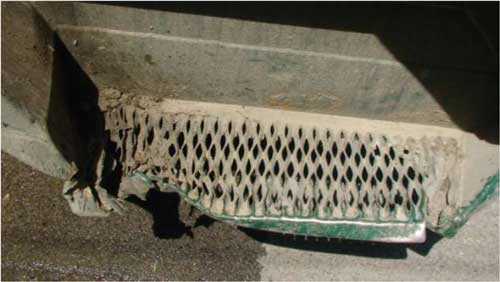 |
Photograph of broken step.. Photograph courtesy of KY Labor Cabinet. |
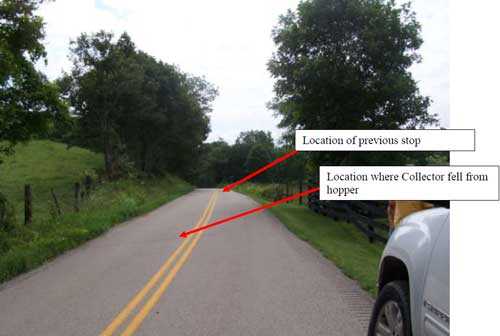 |
Roadway where Collector fell out of hopper of solid waste truck. Photograph by KY FACE |
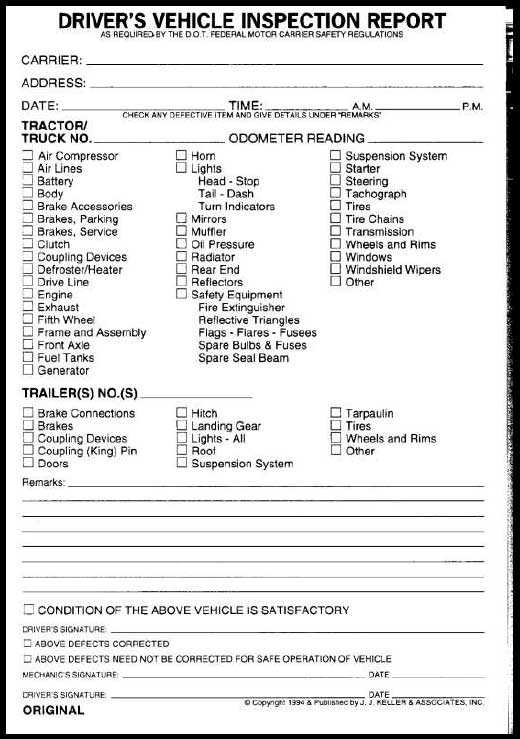 |
Attachment 1: Copy of Department of Transportation's |
Kentucky FACE Program
The Kentucky Fatality Assessment & Control Evaluation Program (FACE) is funded by a grant from the Centers for Disease Control and the National Institute of Safety and Health. The purpose of FACE is to aid in the research and prevention of occupational fatalities by evaluating events leading to, during, and after a work related fatality. Recommendations are made to help employers and employees to have a safer work environment. For more information about FACE and KIPRC, please visit our website at: www.mc.uky.edu/kiprc/ (Link updated 3/27/2013)
To contact Kentucky State FACE program personnel regarding State-based FACE reports, please use information listed on the Contact Sheet on the NIOSH FACE web site. Please contact In-house FACE program personnel regarding In-house FACE reports and to gain assistance when State-FACE program personnel cannot be reached.
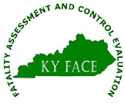
- Page last reviewed: November 18, 2015
- Page last updated: October 15, 2014
- Content source:
- National Institute for Occupational Safety and Health Division of Safety Research


 ShareCompartir
ShareCompartir